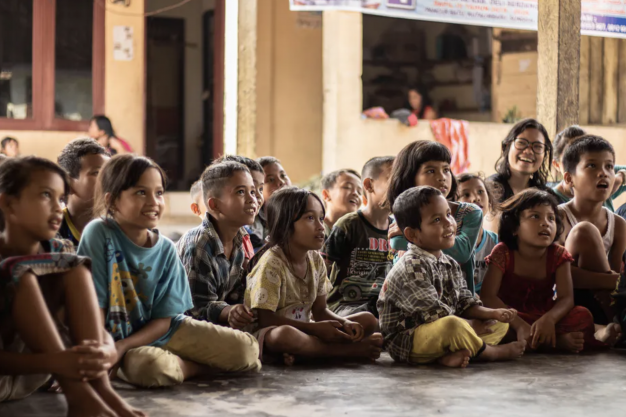
How to design appropriate methods for research involving children – part two
Researchers who explore children’s lives need to carefully design the research to ensure the children can articulate their opinions and experiences in a meaningful way.
Participatory child research actively engages children throughout the research process – as opposed to children serving only as the subject being studied – and it requires the right approach and methodology.
One of the most common approaches in child participatory research is centred on the children’s perspectives and lived experiences. Researchers can encourage children to draw pictures, take photographs, record stories in videos, create scenarios and act out various roles or scenes in role-play to explore children’s perspectives. In the digital era, researchers can also explore various methods through online media, write Clara Siagian, PUSKAPA; Marsha Habib, PUSKAPA, and Santi Kusumaningrum, PUSKAPA.
This article is published through collaboration between PUSKAPA and The Conversation Indonesia, and is the second in a series of two features on ethics, opportunities and challenges in involving children in research. Click here to read part one.
We have compiled the “Handbook for Children’s Participation in Research in Indonesia”. Researchers can refer to this resource to help them design appropriate and ethical methods of child participatory research.
Choosing a research method
Researchers can combine different methods and design various types of activities according to the needs of the research and situations of the children. Regardless of methods, researchers must ensure the children are protected and can enjoy the process. At the same time, the research must uphold the validity and rigour of the data.
Like adults, researchers can involve children in a variety of methods, from questionnaires to action-based methods.
Researchers need to consider all aspects of the child respondents they want to work with, including their identity. Other aspects include their socioeconomic status, cultural context, and disability or non-disability status.
Choosing unsuitable methods may lead to respondents feeling uncomfortable and reluctant to continue participating. In addition, getting the methods wrong risks distorting the research project results so they do not fully represent the life experiences and perceptions of the children.
Researchers must also ensure all children who qualify as participants have equal opportunities regardless of gender, ethnicity, disability/ability, literacy level, school participation or other specific conditions.
Planning and designing research
Research can benefit from involving children as early as possible. This helps them gain a “sense of ownership” of the research and maintain interest throughout the project.
Children’s involvement can begin with discussing objectives, identifying topics and planning, and developing and refining data collection instruments.
Meaningful participation of children can also be sought when collecting data and evaluating field processes, data analysis and validation, and dissemination.
Piloting the techniques with a group of children and asking for their feedback is a common way to involve children in designing data-collection methods and tools.
Preparations for fieldwork
At the preparation stage, including data collection, it is crucial to select appropriate child participants by taking into account their capacity and developmental stage.
In determining a child’s capacity, researchers can consult with the child’s caregivers, siblings, or peers. They can also observe the child’s behaviours in their natural environment, and speak with the child in an informal way ahead of recruitment.
During this activity, researchers must ensure participants are emotionally and psychologically prepared to be actively involved in the research.
Working with children also requires creativity. Researchers should be ready to modify the methods and/or adapt activities and instruments to match children’s capacities. Even during the data collection phase they should be prepared to expand or restrict the scope of children’s eligibility in accordance with the study’s research questions and objectives.
At the fieldwork stage, researchers should take the time to introduce themselves, develop rapport and gain trust. They must also ensure participants and their guardians/parents understand the research and their involvement before finally seeking informed consent.
Before researchers can approach children, they have to explain themselves to various layers of gatekeepers who are key persons in children’s lives and surroundings.
Trust is important as the foundation for any interaction, including research with children. It pays for the researchers to learn how to present themselves to different gatekeepers and how to earn the trust of everyone involved in the study.
Data management and confidentiality
It is important to maintain the confidentiality of the respondents and others involved throughout all stages of the research. It’s especially important when collecting sensitive personal information from children who come from the most vulnerable groups.
Researchers must prevent any breach of information that can reveal a child’s identity to the public. Breaches like this may threaten the child’s safety and well-being.
Researchers need to ensure that the ways they input, categorise, store, share, analyse and disseminate the data do not breach confidentiality agreements and threaten anyone’s safety.
It is also important to be aware of who has the right to access children’s data. In general, research leads, such as principal investigators, would have direct access to sensitive information about children. Later, the research team needs to define specific protocols that set limitations on how external parties can access children’s data.
External parties may need access to a respondent’s personal information. For instance, they may they need to refer a respondent to social workers. Other involved staff, such as interviewers, interpreters, drivers, cultural brokers and administrative staff, may also need access to children’s information for follow-up purposes.
Parents, primary caregivers or members of children’s social networks, however, usually do not have access to children’s responses in the research as it may put respondents in danger.
All research staff could be required to sign a confidentiality agreement. It limits what data can be shared and what should never be shared, as well as with whom different types of data can be shared and under what circumstances.
Data analysis and dissemination of findings
The decision to involve children in data analysis should be considered at the onset of the research as it determines the required time and resources.
The extent to which it is possible or appropriate to involve children in the analysis or interpretation of the data depends on the nature of the research and the interest of children to be involved in this phase of the project. Children’s rights, confidentiality and safety all need to be considered when involving them in data analysis.
Involving children in dissemination begins by discussing when and how researchers can communicate their findings to children effectively. The discussion should include what to do with sensitive information and private content such as photos or videos.
Researchers need to consider children’s participation in conveying the findings to a broader audience. They must weigh up the advantages and risks that may come with this particular form of participation.
In essence, at all stages of the research, researchers need to pay attention to the child participants’ experiences and listen to their voices. That way, researchers get to understand and develop research methods appropriate to the children’s capacities and interests.
“Handbook for Children’s Participation in Research in Indonesia” is produced by PUSKAPA, supported by UNICEF Indonesia and CPC Learning Network at Columbia University. The book is available for free and can be accessed here.![]()
Clara Siagian, Senior Researcher, PUSKAPA; Marsha Habib, Communication and Relations Manager, PUSKAPA, and Santi Kusumaningrum, Director, PUSKAPA
This article is republished from The Conversation under a Creative Commons license. Read the original article.




